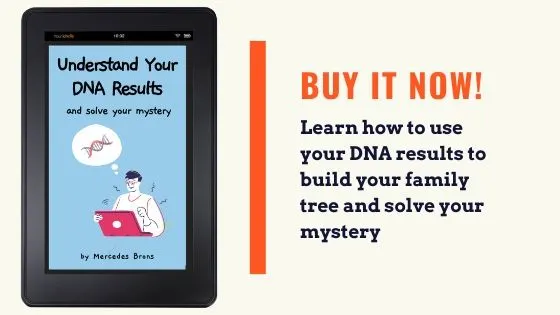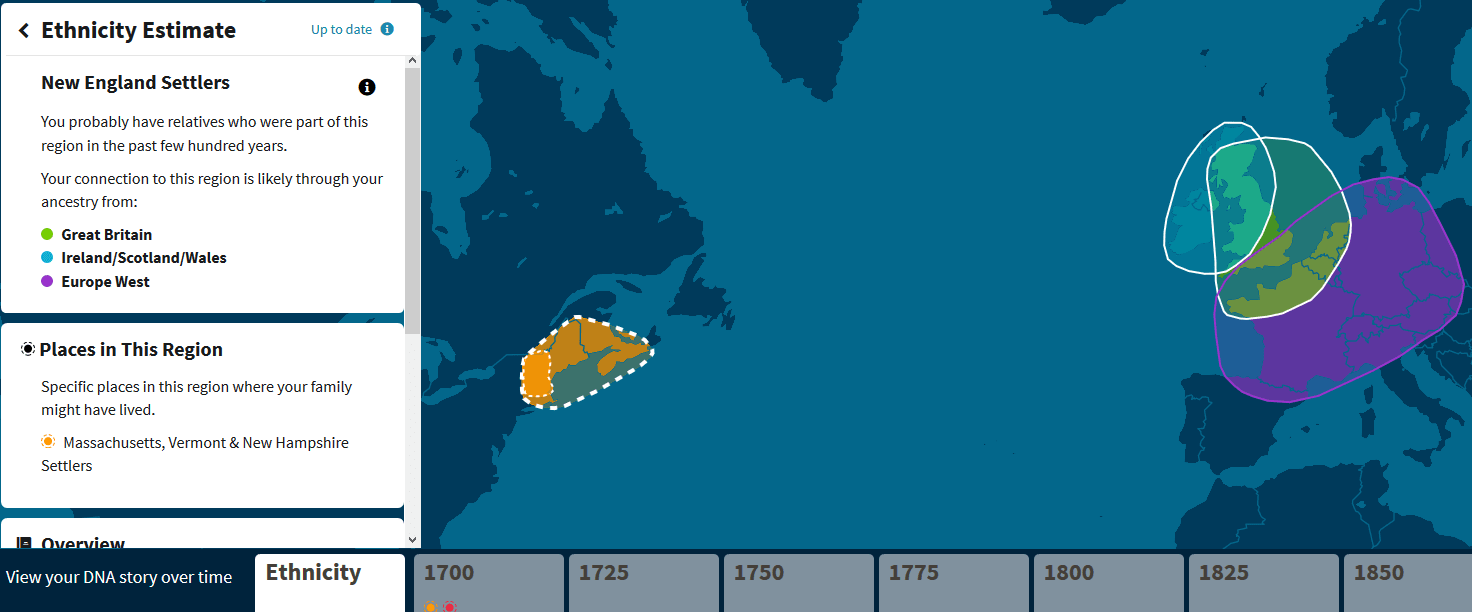
Do you want to see an example of Ancestry DNA results before deciding to get your DNA test? If so, you have come to the right place. In this post, I will show you my DNA results as an example of Ancestry DNA results.

I found that testing with Ancestry DNA was a very positive experience. I had been mildly interested in family history and genealogy since I was a kid, but this DNA stuff took it to a new level for me.
I hope it’s just as much fun for you!
This post was updated June 14, 2019 to reflect the most recent example of Ancestry DNA results
When you first log into Ancestry DNA, you will be taken to a screen that looks like the image below. I have blocked out a few parts of the image for privacy protection.
Ancestry has a beautiful interface and great web design, so I definitely don’t want you to think that you will have those black boxes on your screen.
As you can see in the image, my DNA results are divided into three sections. I can access my DNA Story , DNA Matches, and ThruLines by clicking on those green buttons below each section.
I’ll show some more examples further down in this post, along with some explanations.

Under the DNA Story section, there is a lot of information available about my ethnicity and the Migrations to which I belong. The first part of the DNA Story is my ethnicity estimate.
I am able to click through to see even more information on the estimate, and find out if there are any other ethnicities that I have.
From this image, you can see that I am 43% Germanic Europe . I was actually surprised to learn that – I figured that I would be more England, Wales, and Northwestern Europe.
What kind of surprise will you have?

Under the ethnicity estimate, I can see my Migrations. This is a really neat feature of Ancestry DNA.
If I click on one of the Migrations, it will give me some historical context about why and when my ancestors settled there.
In addition, I can see some of my DNA matches that also belong to the same Migration. This can be very helpful if you are researching your family tree.

Thanks to a comment on this post requesting a more detailed photo of my ethnicity estimate, I decided to add this special section dedicated to displaying a full example of my ethnicity results. Your own estimate will be different, since the information included will depend on your unique personal ancestry.
When you first log in to your results, you will see a pie chart that summarizes your major ethnicity regions. When you click on “DNA Story” you can see a full list of all of your ethnicity regions.
For example, when I expand my results, I can see that I have:

I have roots in Colonial America and some of the later (but early-ish) European migrations to the continent, so I also got two “Migrations” on my ethnicity results. For example, Ancestry says that based on my DNA, I probably had ancestors among the colonists who lived in New England.
As you can see, my connection to this area goes back to the early 1700’s:

Depending on your particular background, you might have DNA that matches one of the 350+ subgroups of the major Ancestry DNA regions. For example, my mother has Eastern European ancestry from Slovakia and Poland, so she was placed in the Czech Republic, Slovakia, Poland & Lithuania sub-region of Europe East:
 example of Eastern European Ancestry DNA results" width="393" height="509" />
example of Eastern European Ancestry DNA results" width="393" height="509" />
A further example of Ancestry DNA results from a non-European tester who belongs to a sub-region of the Native American ethnicity:

Once I was done learning about my ethnicity, it was time to move on to the most exciting part of Ancestry DNA (to me, at least!): My DNA matches! Some people like to call these “cousin matches”, since all but the closest matches are usually some sort of cousin to me.
When I first got my Ancestry DNA results back, I had 43 genetic matches (DNA matches) that matched me at a 4th cousin distance or closer. As of January 29, 2019, I have 496 DNA matches that match me at this same distance.
I get new DNA matches almost every day!
I think it’s pretty cool that we still get new DNA matches even if we did our DNA test years ago.
The image below is what the match screen currently looks like. Of course, it will be a little different for everyone, depending on how many relatives of yours have taken the test, and how closely they are related to you.

The DNA matches will be grouped into a predicted relationship type. The only relationship predictions that are practically guaranteed to be 100% accurate are the parent/child relationships.
This isn’t because the test results are wrong, however. Ancestry “predicts” your relationship to your DNA matches based on
For example, my daughter, my mother, and my father have taken the test. On my daughter’s test results, she is told with extremely high confidence that I am her mother.
On my test results (shown above), you can see that Ancestry tells me with certainty that those two DNA matches are my mother and father. Phew!

When you click on one of your DNA matches, you will be taken to a new page where it gives you more complete information about them. You will typically be able to see the match’s ethnicity, including trace ethnicity, the amount of DNA that you share, whether or not you have shared matches, and a contact button to be able to send them a message.
In addition, if you have an Ancestry subscription, you will be able to view their family tree and see whether you have surnames in common.
The last thing that I want to mention about the DNA match screen is those little “tree leaves” that you see right next to the “View Match” button. Those little leaves mean that Ancestry DNA has compared your family tree to theirs and has found a common ancestor.
This is a cool way to kind of “prove” that your family tree is correct – especially for closer matches!
The final area of my DNA results are the ThruLines that Ancestry DNA has discovered for me. If you have a family tree on Ancestry, as I do, you could get ThruLines on your DNA results, too.
ThruLines are formed when Ancestry DNA is able to determine a common ancestor shared between you and your DNA match(es). Ancestry uses information from family trees and your DNA matches in order to determine how you might be connected.
ThruLines are quickly becoming my favorite feature!
The image below shows an example of one of my Ancestry DNA ThruLines. I’m descended from Christjaan, who was my 4th great-grandfather. I knew about his son, Eltje, but I didn’t know that Eltje had two brothers.

My DNA matches, Abe and Ray, are descended from two of Eltje’s brothers. My ThruLines shows me exactly how they are descended.
I can always do a little independent checking to verify the information learned in my ThruLines, just in case. The amount of time ThruLines saves is very valuable, however.
If you haven’t done your Ancestry DNA test, now is a great time to start. It usually takes between 4-6 weeks to get your results back with most companies, so don’t wait!
I hope that this post helped you get an idea of what to expect when you do your Ancestry DNA test. DNA testing has been a great experience for me, and I hope that you enjoy it as much as I have.
Thanks so much for stopping by. I would love to hear from you in the comments!